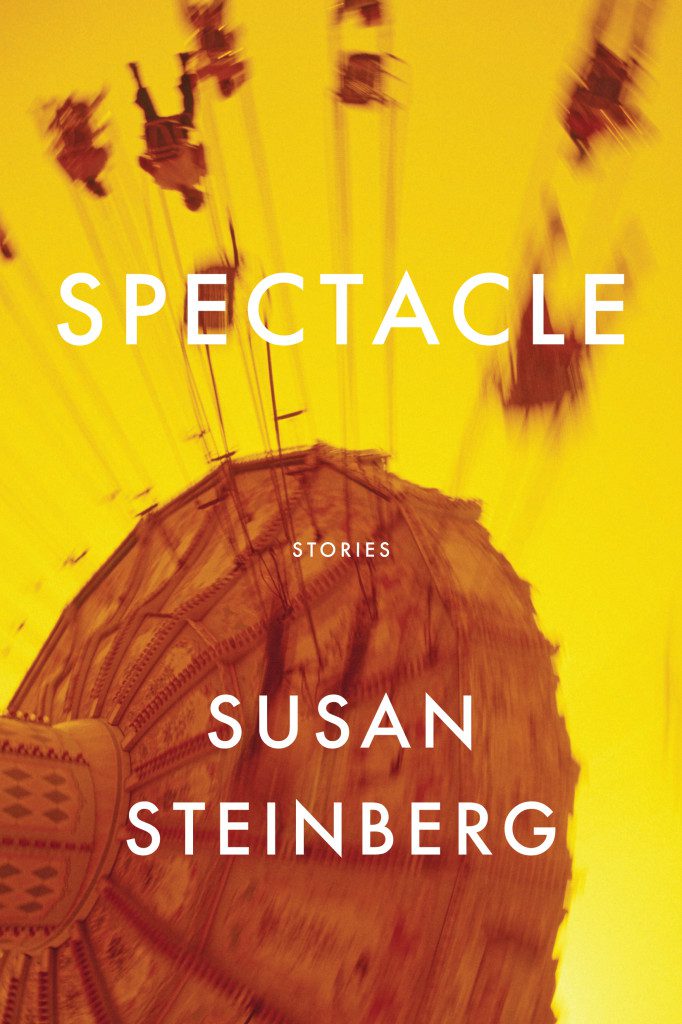
To read Susan Steinberg’s short stories in Spectacle, her latest collection from Graywolf Press, is like experiencing a hypnotic trance from which when you emerge, the world is different. It’s clearer somehow; lit up by her prose. Her sentences are sometimes raw and sometimes rhythmical. She has the eye of a painter, and it’s no surprise—she’s an artist, in addition to being a writer. But there’s also a musicality to her writing.
In the Puschart Prize-winning story “Cowboys,” for instance, you get a taste of how she uses repetition in a powerful way:
There are no more details to tell.
There is no reason to go into the why of my father.
Or the why of madness, which I cannot answer.
Or the why of addiction, which I also cannot answer.
Or the why of poor, which I also cannot answer.
Suffice it to say it’s always about a loss of something. Then a loss of some things. Then a loss of all things.
Her writing is a hymn to the broken but also to hope. In “Signifier,” for instance, she opens the story with, “Because words are about desire and desire is about the long-tailed birds in the trees.”
I spoke with her via e-mail about the latest VIDA statistics, the lyric essay, and her writing process.
***
The Rumpus: The stories in Spectacle share a lot in common with prose poems. There’s a repetition and a rhythm to your writing that entrances the reader. There’s a rawness to your work, too. Where would you say this comes from? Are you drawn to cross-genres?
Susan Steinberg: I’ve been asked to discuss my formal and stylistic decisions/tendencies a lot since the book came out, and it’s helping me to better understand why I write how I do. The best I can do for now is to say I was a painter before I started writing, and my stories grew directly out of this. I hadn’t studied literature in any traditional sense, only the visual arts, and I incorporated writing into my paintings before I moved to writing on the page. I’ve never written what one would call “conventional” fiction, and there was a time I didn’t even understand the distinction.
And I am drawn to some cross-genre work, particularly the lyric essay.
Rumpus: What made you transition from painting to writing? Do you still paint?
Steinberg: The transition was mostly seamless—for a few years, I was trying to do both, then writing took over. I liked that it was non-toxic and free and that I could do it anywhere. I haven’t been painting lately, but last summer I bought a box of colored pencils, and I’ve been drawing my legs and shoes.
Rumpus: How is writing similar to painting?
Steinberg: The process is very similar for me: in both, I first put a lot on the page/canvas, then scrape most of it off, or pare it down, to get to what I want to say. And I always work on several pieces at once.
 Rumpus: The women in your stories are full of desire, but often broken in some fundamental way. There’s a tremendous strength beneath their fragility, though. You write about a woman deciding whether to take her father off of life-support, for example, and a woman who steals the radio out of the car of a boy she likes. These are women who are trying to find their way in this world. Is their desire born out of your own desire?
Rumpus: The women in your stories are full of desire, but often broken in some fundamental way. There’s a tremendous strength beneath their fragility, though. You write about a woman deciding whether to take her father off of life-support, for example, and a woman who steals the radio out of the car of a boy she likes. These are women who are trying to find their way in this world. Is their desire born out of your own desire?
Steinberg: I want to say no, but I think the answer is yes. I mean, I don’t have a desire to steal a car stereo, but, like my narrators, I have a desire to confront and to connect and to make sense of things. I suppose I’m saying that in my writing, I push these basic desires to more extreme places. But perhaps that’s just differentiating between life and art.
Rumpus: You’re a founding chair of VIDA. What are your thoughts on the recent VIDA statistics?
Steinberg: I just took a look at the new numbers; they look a lot like the old numbers. That is to say, they’re disappointing, but not surprising.
Rumpus: It seems like the VIDA statistics are circulated, and many people get upset, but enough changes aren’t made. Yet there’s hope; particularly with recent announcements, like Pamela Paul being named editor of the New York Times Book Review. Are you hopeful?
Steinberg: When I was working with VIDA—I was on the board until last year—we were concerned with starting, or restarting, a dialogue about gender disparity in the literary arts. And you’re right to suggest that people have entered the dialogue, but that not enough has changed. At this point, perhaps it goes without saying that the magazines whose numbers are the most imbalanced don’t actually want to change. If that’s the case, then is it time to start dismissing them in the way they’ve dismissed us and focus on those places that actually support women? Because those places do exist. And I am hopeful.
Rumpus: Who are some of the female writers who have most influenced you?
Steinberg: I was initially influenced by visual artists, especially some of my female peers in art school. The work I liked most was just brutal and fearless and vulnerable, and it inspired me to take more risks in my own art. As for published writers, I love Woolf and Duras, though I came to them late.
Rumpus: Virginia Woolf is my favorite writer! I don’t think it’s ever too late to read Woolf. What’s your favorite Virginia Woolf book, and why?
Steinberg: To the Lighthouse. I love everything from the line-by-line writing to the structure of the book as a whole. And Mr. Ramsay is the perfect narcissist.
Rumpus: You wrote a fantastic essay about experimental writing for Publishers Weekly. I was struck by this passage:
I’ve learned that the term experimental makes some people uneasy. I try to imagine what they imagine. Words scattered violently across a page. Numbers instead of letters. Violated punctuation. And I guess I understand why there could be resistance; there often is to that which goes against our expectations. But in art, I often want my expectations, which are generally low, to be shattered.
Why are your expectations often low when it comes to art?
Steinberg: This is going to sound negative, but I’ve come to expect a lot of formula and imitation. And then I encounter work that pushes past all this, and I remember why I keep at it.
Rumpus: Why have you come to expect a lot of writers are copying others? Is that the status quo these days? Are we not seeing many original writers?
Steinberg: I’m not saying artists shouldn’t borrow from or quote or be influenced by other artists. On the contrary, this is often where great art begins. And I’m not even sure where I stand on the idea of originality. I’m speaking more of certain, often-changing trends in the arts: shortcuts and tired approaches that are overused, or not well-used, or not understood by the users, and yet somehow accepted, perhaps because of the comfort in their predictability. I feel like I keep running into that. But again, I’m just talking about formula. It’s where art dead-ends.
But there are a lot of great things happening both in the visual arts and in writing.
Rumpus: What is it about the lyric essay that you like? Do you plan to write a book of lyric essays at some point?
Steinberg: In addition to its attention to language and/or form, I like that it automatically upends the expectation that the essay has an obligation to deliver fact, as opposed to some version of truth.
I guess it’s possible that I could write some lyric essays in the future. I think I’m too much of a coward, at this point.
Rumpus: I don’t think you’re a coward. What makes you feel like a coward?
Steinberg: My cowardliness has to do with the essay part, not the lyric part. I haven’t written much nonfiction.
Rumpus: What kind of risks do you take with your writing?
Steinberg: There are risks involved in formal experimentation and risks involved in writing confrontational or provocative or vulnerable female narrators. One risk of each is that my work is often re-categorized as poetry (because of the former) or nonfiction (because of the latter).
Rumpus: You have a way of making a gritty detail seem attractive and even visually pleasing. In “Supernova,” for instance, you talk about how “the mechanic was beautiful, with black beneath every nail.” Do you find yourself looking for the beauty in things other people might find ugly?
Steinberg: I don’t find myself looking for it, but I always see it.
Rumpus: Do you ever think about working on a book in which you incorporate some of your artwork?
Steinberg: I used to work on pieces that incorporated both written text and images. I wrote on my paintings, and I used to make these books with water-soluble crayons and ink on this torn up rice paper—they were a mix of drawing and writing. I could see doing more of that.
Rumpus: What are you currently working on?
Steinberg: I’m working on a collection of short stories.
Rumpus: You’re the author of three short story collections. Do you plan on writing a novel at some point? Why are you drawn to short stories?
Steinberg: I prefer writing and reading short stories. There’s something about working in a series. And something about the size. I feel like I have control over the form. And it’s satisfying to complete things.




